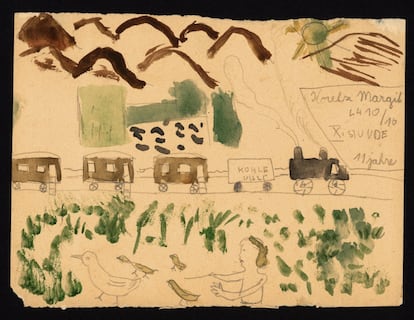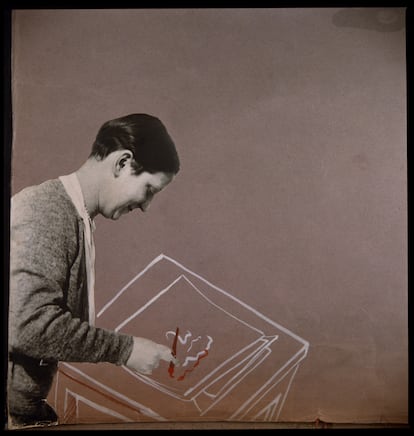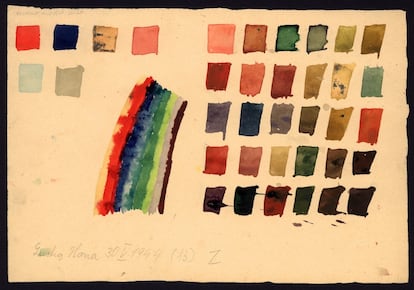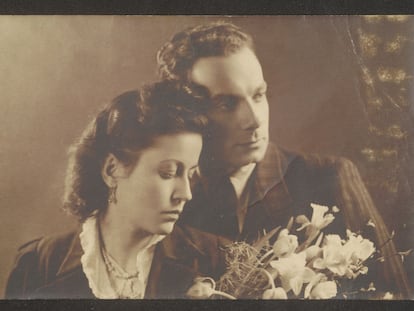The abbreviated genius of Friedl Dicker-Brandeis, multifaceted artist and teacher
Three exhibitions in Austria honored the versatile polymath and avant-garde painter murdered by the Nazis in the Auschwitz-Birkenau extermination camp

We now know that the hand of Friedl Dicker-Brandeis was behind the cheerful and colorful drawings of Jewish children in the Terezín model ghetto near Prague (Czech Republic). Her art program served to teach and distract the children from the oppressive reality of the ghetto, established as a waystation to the Nazi extermination camps. But less is known about Dicker-Brandeis herself, a Jewish woman born in Vienna in 1898. By the time she was sent to Terezin, Dicker-Brandeis was well-known as a multidisciplinary Bauhaus artist, avant-garde painter, experimental teacher, interior designer of aristocratic salons, charismatic passport forger, and creator of posters promoting anti-fascist ideology and feminism. Her deep artistic credentials have always been overshadowed by the personal tragedy of her murder at Auschwitz.
In 2022, three Austrian exhibitions of Dicker-Brandeis’ work celebrated the woman and her art. The Wien Museum MUSA focuses on her years in the Bauhaus art movement, and exhibits a reconstructed studio she shared with architect Franz Singer in Vienna in the 1920s. Both trained at the Bauhaus art school in Weimar (Germany) where they absorbed its sophisticated and practical approach of unifying design and architecture. The museum exhibits an original compendium of axonometric drawings, models, furniture, photographs and collages. “Creating this exhibit was almost like an archeological project,” said Andreas Nierhaus, curator of the Wien Museum. “The studio’s most important projects were destroyed during the Nazi period, but its archive was miraculously preserved.”
Among the exhibits are the plans for Hans Heller’s private tennis club, for whom Dicker-Brandeis also served as interior decorator, and the blueprints for Countess Hildegard von Auersperg’s residence. Photos of completed projects reveal the functional design of radically diverse spaces like the haute couture salon of Lore Kriser & Co, and a Montessori kindergarten. Singer and Dicker-Brandeis both worked for an open-minded clientele, mostly Jewish intellectuals and artists looking for modern spaces that departed from the traditional Viennese style.

Singer and Dicker-Brandeis separated professionally and romantically in the 1930s. He was a married man in a dysfunctional relationship, and Dicker-Brandeis was beginning to work with the Communist Party. She effectively imbued her activism with creativity, and when she was jailed for forging passports for her comrades, she set about embroidering her prison uniform. When Franz Singer testified at the trial, he explained their relationship with a caustic quip: “Friedl is incapable of drawing a straight line.”
After her release from prison, Dicker-Brandeis continued designing propaganda posters for the Communist Party. Her black-and-white photocollages excoriated working class living conditions, forewarned of the impending Nazi threat, and decried the crises of capitalism as enablers of totalitarianism. One of the eight glass plate negatives on exhibit displays a cutout of Adolf Hitler, while another depicts the constricting role of women in industrial society. The negatives were used to print large-format Dadaist photomontages that Dicker-Brandeis was forced to destroy before going into exile.
The troubling rise of fascism in Austria convinced Dicker-Brandeis to emigrate to Czechoslovakia, where she married her cousin, Pavel Brandeis. In Prague, she taught school and continued creating avant-garde art. While in Vienna, she taught kindergarten teachers how to use art as therapy, and now her pupils included children who had fled Nazi Germany with their families. She applied her art therapy principles to deal with her own monsters, and drew a series of expressionistic self-portraits set against the traumatic backdrop of her arrest and interrogation.

The autumn exhibit at the Heiligenkreuzerhof museum in Vienna displayed a painting by Dicker-Brandeis titled Fuchs Learns Spanish, a surrealistic allegory of the Spanish Civil War. The exhibit curator is Cosima Rainer, the editor of a canonical catalog of Dicker-Brandeis’ work. “How is it possible that Dicker-Brandeis didn’t get her proper due until now?” asks Rainer. “Her role in the development of experimental forms of expression is unique in the interwar period. She did it all. Paradoxically, that same versatility also hindered her recognition.” The first exhibition dedicated to Dicker-Brandeis this year was presented by the Lentos Art Museum in Linz (Austria).
Dicker-Brandeis initially found weightlessness in art and gravity in politics, but as time went on, it was the other way around. When she was deported to Terazin, she found a lifeline in stimulating the creative instincts of children. She was horrified to see a Red Cross delegation inspect the ghetto in June 1944 and later tell the world that no atrocities were being committed there. The German voiceover of the propaganda film released after the Red Cross inspection describes a paradise on Earth: “Who wouldn’t want to live here?”
Shortly thereafter, in October 1944, she volunteered to make the trip to Auschwitz to join her husband, who had been taken there days earlier. Dicker-Brandeis was oblivious to the fate that awaited her there, and left behind several suitcases with almost 5,000 children’s drawings and collages. Dr. Josef Mengele greeted the train when it arrived in Auschwitz, selecting passengers for his gruesome medical experiments as they disembarked. Her husband survived the Holocaust, but Friedl Dicker-Brandeis died in a gas chamber at the age of 46.
STUDIO BAUHAUS, VIENNA Friedl Dicker and Franz Singer, through March 26, 2023 at Wien Museum MUSA
Sign up for our weekly newsletter to get more English-language news coverage from EL PAÍS USA Edition
Tu suscripción se está usando en otro dispositivo
¿Quieres añadir otro usuario a tu suscripción?
Si continúas leyendo en este dispositivo, no se podrá leer en el otro.
FlechaTu suscripción se está usando en otro dispositivo y solo puedes acceder a EL PAÍS desde un dispositivo a la vez.
Si quieres compartir tu cuenta, cambia tu suscripción a la modalidad Premium, así podrás añadir otro usuario. Cada uno accederá con su propia cuenta de email, lo que os permitirá personalizar vuestra experiencia en EL PAÍS.
¿Tienes una suscripción de empresa? Accede aquí para contratar más cuentas.
En el caso de no saber quién está usando tu cuenta, te recomendamos cambiar tu contraseña aquí.
Si decides continuar compartiendo tu cuenta, este mensaje se mostrará en tu dispositivo y en el de la otra persona que está usando tu cuenta de forma indefinida, afectando a tu experiencia de lectura. Puedes consultar aquí los términos y condiciones de la suscripción digital.
More information
Archived In
Últimas noticias
Most viewed
- Sinaloa Cartel war is taking its toll on Los Chapitos
- Oona Chaplin: ‘I told James Cameron that I was living in a treehouse and starting a permaculture project with a friend’
- Reinhard Genzel, Nobel laureate in physics: ‘One-minute videos will never give you the truth’
- Why the price of coffee has skyrocketed: from Brazilian plantations to specialty coffee houses
- Silver prices are going crazy: This is what’s fueling the rally











































